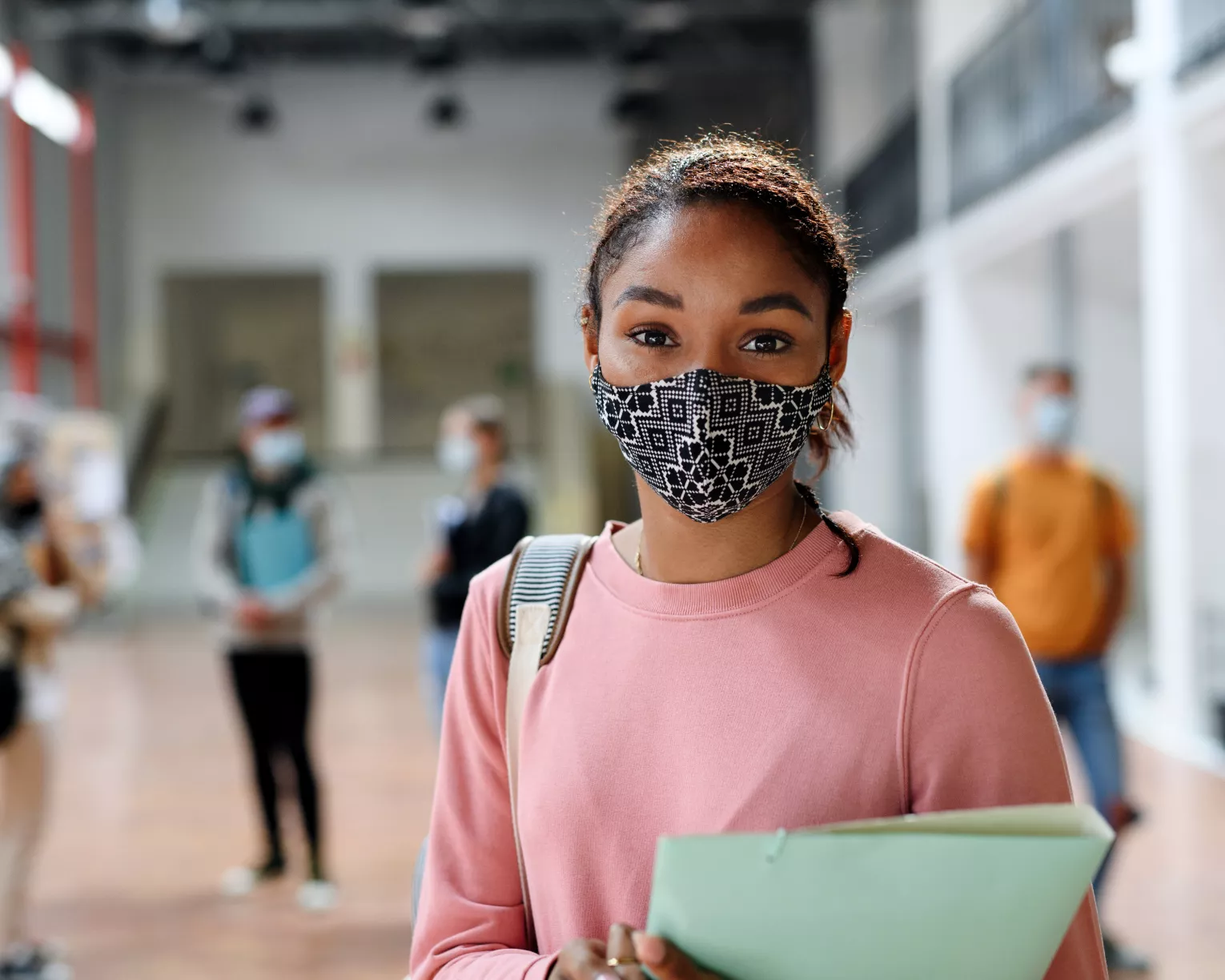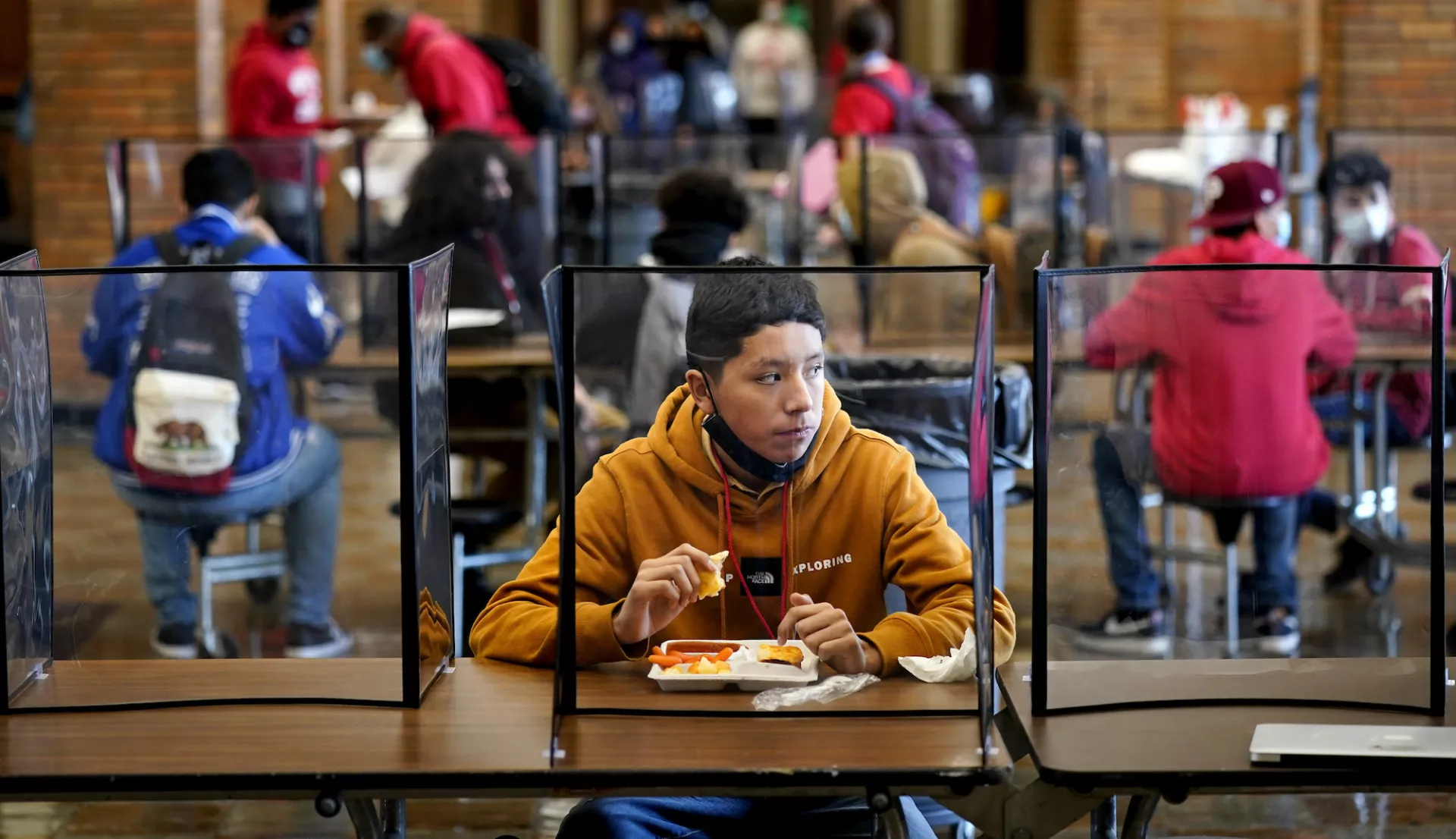Even with the best mitigation measures in place throughout the school day, the possibility of viral transmission increases when students gather unmasked during school meals.
Initially, eating meals in classrooms may seem like an easy-to-implement solution for increasing safety amid the pandemic, but it raises just as many questions as it answers, including those related to the adequacy of classroom ventilation1 and physical distancing; the implications of preparing and/or serving food and then removing waste from classrooms; the need to safely and effectively clean classroom surfaces after meals and address pest-management issues; and the workforce implications of monitoring mealtime in classrooms. School districts must factor equity issues—such as exposure to air pollution in outdoor eating areas, student access to appropriate outdoor clothing if required by the weather, and air quality resources in historically neglected or under-resourced schools to ensure safe indoor meals for students and educators—into their COVID-19 meal plans.
Any plans for reducing risks during mealtime must account for ventilation—the circulation of outside air to dilute harmful contaminants—and filtration—the removal of viral aerosols from the air. Proper ventilation and filtration are essential to improving indoor air quality and reducing the risk of COVID-19 transmission in schools. See the Guidance for the Re-Opening of Schools from the American Society of Heating, Refrigerating and Air-Conditioning Engineers (ASHRAE). For additional information, refer to the NEA’s ventilation guidance, which is based on recommendations by the CDC and other groups.
Options for School Meals
Outdoor Meals
Many schools and districts are offering outdoor meal options, weather permitting, to prevent the spread of COVID-19. Because transmission is generally lower outdoors than indoors, outdoor meals can decrease the potential for transmission of the disease. In addition, students may be better equipped to maintain a safe social distance outdoors than they are inside a school building. For more information, see the CDC’s Guidance for COVID-19 Prevention in K–12 Schools. That said, weather and outdoor air conditions, the amount and type of available outdoor spaces, and the ability to provide appropriate oversight must be considered. Notably, schools in communities of color are likely to be less safe due, in part, to inequities in school facilities that existed prior to the pandemic.
Meals in a Cafeteria or Other Large Indoor Space
Eating meals in a well-ventilated cafeteria that also offers excellent air filtration can provide another good alternative. Other considerations for reducing risk in a cafeteria include staggering students by grade level; maintaining space at lunch tables (e.g., keeping enough seats empty to create necessary physical distance); feeding students in the same cohorts in which they learn; and limiting time spent waiting in line for school-provided meals. If a school is unable to implement one or more of the four risk-reduction measures described above and occupancy in the cafeteria is high, other spaces should be considered to make mealtimes safer. Other well-ventilated, large indoor spaces, such as a gymnasium or library, may be a suitable option provided that the four meal-related risk-reduction strategies mentioned in the paragraph above have been implemented to the greatest extent possible.
Meals in a Classroom
If schools and districts are unable to accommodate outdoor meals and/or distanced meals in a cafeteria or other large indoor space with appropriate risk-reduction measures in place, meals in a classroom may be a suitable alternative. However, the following issues must be addressed prior to implementing this option:
- Trash created during meals—including eating utensils, leftover liquids, and food items—must be disposed of and removed from the classroom promptly to prevent odors, pest problems, and other indoor air quality issues, which may require additional custodial services and equipment (e.g., additional custodial work and trash cans).
- Surfaces must be cleaned properly before and after meals. Exercise caution any time cleaning products are used around children; exposure to airborne chemicals may cause serious health problems for all individuals exposed but is particularly risky for children. For more information, check out the Population Reference Bureau’s resource on children’s environmental health. Exposure to airborne chemicals also can cause or exacerbate respiratory issues, such as asthma. Other potential concerns include issues with storage and spillage of cleaning chemicals and serious problems associated with inappropriately applied chemicals. For additional information on appropriate cleaning, see the NEA’s guidance on cleaning and disinfecting in the COVID-19 era.
- Protections need to be in place for students with food allergies. Schools should have a coordinated approach for managing food allergies across all environments of the school setting. Eating in nontraditional areas may require adjustments to health and safety plans and training of staff who are new to overseeing school meals. For more information, check out the CDC’s guidelines for managing food allergies in schools.
- Equity issues must also be factored into decision-making about whether and when to eat in classrooms. It is worth considering extended meal periods to accommodate students with disabilities, younger students, students who need to wait in line to retrieve their meals, and those who need additional time washing their hands before meals. Further, sufficient time must be allotted for all meal-related activities, including hand-washing, procuring food, and cleaning up; all schools should dedicate a minimum of 20 minutes for consumption of meals.
Using Collective Bargaining or Meet-and-Confer
Making mealtime safe is not an easy task amid a pandemic, but many affiliates have negotiated memoranda of understanding (MOUs) with school districts to address modifications to existing mealtime procedures, including staffing assignments, compensation, and health and safety mitigation issues, among others. If your local has not done so, most collective bargaining agreements contain enforceable language covering these issues. Even where bargaining is not permitted, your local can discuss these issues with administrators, either as part of a labor-management committee or through meet-and-confer opportunities. The NEA has produced additional resources that provide bargaining and advocacy recommendations to address some of the workload, workday, and staffing issues that have impacted NEA members during the COVID-19 pandemic.
Implementing all Appropriate Mitigation Measures
In addition to the four meal-related risk-reduction strategies discussed in this document, broader COVID-19 risk-reduction strategies must be applied, including universal masking, physical distancing, proper hygiene, appropriate ventilation and filtration, screening testing, contract tracing, quarantine, and isolation. Vaccination against COVID-19 remains a crucial strategy for leading us out of the pandemic.
Federal resources such as Elementary and Secondary School Emergency Relief (ESSER) funds can provide students with social, emotional, and academic supports and be used to implement mitigation strategies to ensure the health and safety of all building occupants. For example, ESSER funds can be used to improve the indoor air quality in school facilities, including improving or replacing HVAC systems; purchasing air filters, portable air cleaning devices, and fans; and providing supplies to clean and disinfect school facilities. Funds can also be used to ensure all students and staff have personal protective equipment (PPE); provide training and professional development for staff on cleaning and minimizing the spread of infectious diseases; reduce class sizes and modify spaces to comply with social distancing; and hire more school custodians, nurses, and counselors.
The NEA’s Federal Emergency Aid for Public Education: A Guide to Funding Amounts, Uses, and Requirements will help members understand the available emergency resources for public schools; identify the activities, programs, and services the funds support; and advocate for evidence-based solutions for students. You also can use the ARPA Fund Use Checklist to quickly identify allowable ESSER funding priorities.
1. Many schools had notoriously poor ventilation systems before the COVID-19 pandemic. In fact, a recent report by the U.S. Government Accountability Office (GAO) found that “an estimated 41 percent of districts need to update or replace heating, ventilation, and air conditioning (HVAC) systems in at least half of their schools, representing about 36,000 schools nationwide that need HVAC updates.” See GAO’s June 2020 Report to Congressional Addressees. The pandemic highlighted the importance of ventilation and filtration, and it prompted districts nationwide to scramble to assess, fix, and/or update their HVAC systems.
Downloads
Join Our Movement


